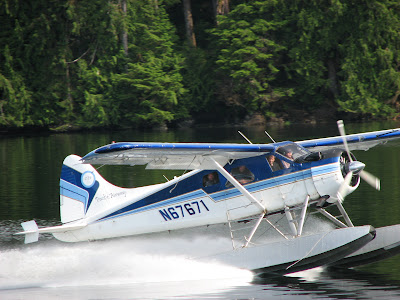
Dawn Breaks in Gardner Bay
Foreword:
Jon Bender was a deckhand around 12 years ago at our Southeast Alaska fishing resort, Sportsman’s Cove Lodge. (See www.alaskasbestlodge.com). He was about 20 years old when he wrote this. He sent it to me a year or so ago. I have edited it only slightly to update some facts and changes in fishing regulations that have occurred since Jonathan wrote this. The trip he is describing is the third day of a four-day package. Jon has been fishing with the group for two days prior to this. I hope you enjoy his perspective, which is representative of all of the staff at the Lodge, and in particular the deckhands. I will post it in several parts.
Captain MacJonathan Bender’s Cape Chacon
Part I
It’s early. Though it’s plenty light enough to function, the sun has yet to peek through the opening at the east end of the small cove. The black sea is glassy, calm. Surrounding us on three sides is a series of rocky, knobby peaks, their flattened tops dropping off precipitously into the water of the cove. This area is so often and so violently windswept that the characteristically dense forest that carpets the rest of the island has never gained much of a foothold on the bedrock. Instead, resilient chartreuse lichens contrast against dark green moss and gray-black rock. Looking around, it’s easy to visualize the glaciers that, thousands of years ago, scoured out the depression in which we are anchored, now filled by the sea.
Our four charterboats are rafted up together in Gardner Bay, about 10 miles from Cape Chacon (pronounce shack-un). The other crews are beginning to stir. I eat my breakfast while prepping the gear for the day. There’s a lot to do; things are going to get hectic. The Alaska dawn comes slowly while I work and soon we hear the sound of the floatplanes, venerable de Havilland Beavers, delivering our guests. The skilled coastal bush pilots always offer a scenic and exhilarating ride, but particularly so in this case, as they maneuver expertly to land on such a small stretch of water; but short landings are their specialty, the reason why the Beavers were consigned this day. After circling above the edge of the surrounding peaks, assessing the landing zone for wind, downdrafts and any debris that might be in the cove, they descend in an arcing approach, touch down smoothly, and once firmly on the water, raise the nose steeply to come “off the step” and slow the aircraft in as short a distance as possible. Captain Mac, watches with a critical and appreciating eye. With just a touch of envy he mutters, “Poetry in motion,
just watching these guys.” And don’t worry, they know he is watching too.
One by one, the floatplanes carefully pull alongside the outside boats of our raft. Aluminum and fiberglass don’t mix so fenders and many hands help to keep the two apart. And one by one the planes discharge their cargo of passengers, lunches and raingear and drift away before starting engines and launching off towards the entrance of the cove in a blur of noise and spray.
As the guests come aboard there are happy greetings and elated descriptions of the almost hour-long low altitude flight down the eastern shore of Prince of Wales Island. Excitement and anticipation fills the air. You could cut it with a knife.
We pick the anchor, turn loose of the other boats and head for the opening that will take us out of the cove toward the open water beyond.
“Okay folks, it’s all business from here on out,” I announce. “You should probably get some stretching in, calisthenics; whatever your pre-workout routine.” My comments are met with some blank looks, eyes peeled open, focusing on a much-anticipated near future that’s dissolving into the present. I’d started to prepare them the previous day, but I don’t think they quite understand what they’re about to be a part of. The fun is about to begin.
To be continued...
++++++++++++++++++++++++++++++++++++++++++++++














